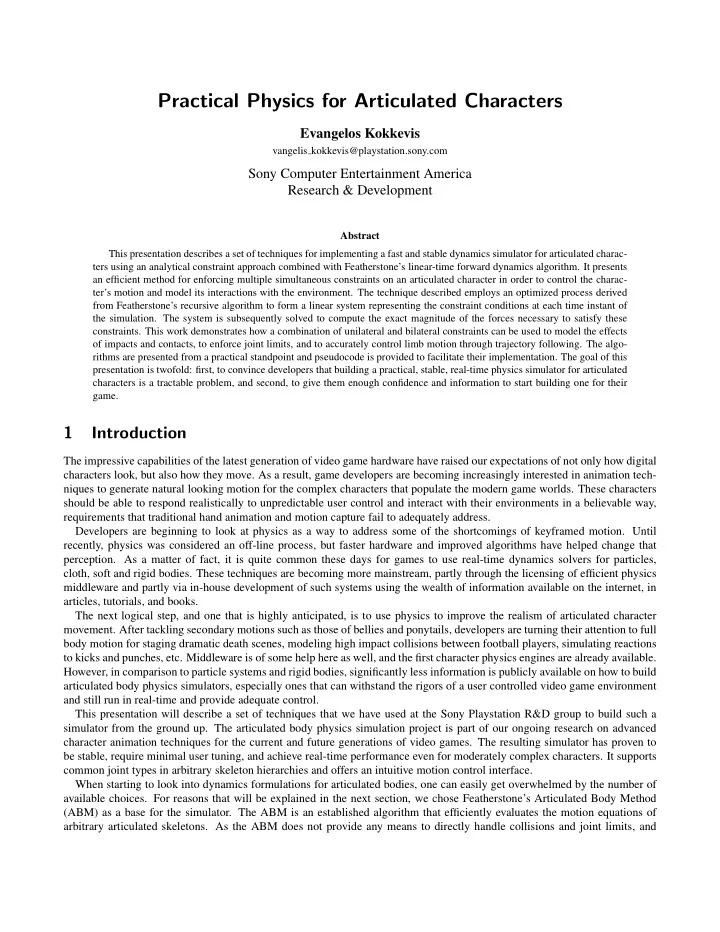

Practical Physics for Articulated Characters Evangelos Kokkevis vangelis kokkevis@playstation.sony.com Sony Computer Entertainment America Research & Development Abstract This presentation describes a set of techniques for implementing a fast and stable dynamics simulator for articulated charac- ters using an analytical constraint approach combined with Featherstone’s linear-time forward dynamics algorithm. It presents an efficient method for enforcing multiple simultaneous constraints on an articulated character in order to control the charac- ter’s motion and model its interactions with the environment. The technique described employs an optimized process derived from Featherstone’s recursive algorithm to form a linear system representing the constraint conditions at each time instant of the simulation. The system is subsequently solved to compute the exact magnitude of the forces necessary to satisfy these constraints. This work demonstrates how a combination of unilateral and bilateral constraints can be used to model the effects of impacts and contacts, to enforce joint limits, and to accurately control limb motion through trajectory following. The algo- rithms are presented from a practical standpoint and pseudocode is provided to facilitate their implementation. The goal of this presentation is twofold: first, to convince developers that building a practical, stable, real-time physics simulator for articulated characters is a tractable problem, and second, to give them enough confidence and information to start building one for their game. 1 Introduction The impressive capabilities of the latest generation of video game hardware have raised our expectations of not only how digital characters look, but also how they move. As a result, game developers are becoming increasingly interested in animation tech- niques to generate natural looking motion for the complex characters that populate the modern game worlds. These characters should be able to respond realistically to unpredictable user control and interact with their environments in a believable way, requirements that traditional hand animation and motion capture fail to adequately address. Developers are beginning to look at physics as a way to address some of the shortcomings of keyframed motion. Until recently, physics was considered an off-line process, but faster hardware and improved algorithms have helped change that perception. As a matter of fact, it is quite common these days for games to use real-time dynamics solvers for particles, cloth, soft and rigid bodies. These techniques are becoming more mainstream, partly through the licensing of efficient physics middleware and partly via in-house development of such systems using the wealth of information available on the internet, in articles, tutorials, and books. The next logical step, and one that is highly anticipated, is to use physics to improve the realism of articulated character movement. After tackling secondary motions such as those of bellies and ponytails, developers are turning their attention to full body motion for staging dramatic death scenes, modeling high impact collisions between football players, simulating reactions to kicks and punches, etc. Middleware is of some help here as well, and the first character physics engines are already available. However, in comparison to particle systems and rigid bodies, significantly less information is publicly available on how to build articulated body physics simulators, especially ones that can withstand the rigors of a user controlled video game environment and still run in real-time and provide adequate control. This presentation will describe a set of techniques that we have used at the Sony Playstation R&D group to build such a simulator from the ground up. The articulated body physics simulation project is part of our ongoing research on advanced character animation techniques for the current and future generations of video games. The resulting simulator has proven to be stable, require minimal user tuning, and achieve real-time performance even for moderately complex characters. It supports common joint types in arbitrary skeleton hierarchies and offers an intuitive motion control interface. When starting to look into dynamics formulations for articulated bodies, one can easily get overwhelmed by the number of available choices. For reasons that will be explained in the next section, we chose Featherstone’s Articulated Body Method (ABM) as a base for the simulator. The ABM is an established algorithm that efficiently evaluates the motion equations of arbitrary articulated skeletons. As the ABM does not provide any means to directly handle collisions and joint limits, and
Recommend
More recommend